Zalman HD-160 and Accompanying Products
by Joshua Buss on March 31, 2006 12:05 AM EST- Posted in
- Cases/Cooling/PSUs
HD-160 Case - Exterior
Like any good HTPC case, the HD-160 makes a great immediate first impression, with a simple, uncluttered front and general design characteristics that should blend in well in any home theater situation.
A few promininate features include the VFD display, volume knob, and the hidden media slots/ports access. Also note the large vent on the top towards the rear. In this next more head-on shot, the clear labels are easier to see. Without a lot of extra buttons or features on the front, the HD-160 should be a breeze to use, even for a complete beginner to the HTPC realm, and the volume control is a nice touch that only adds to this concept.
An extremely close-up picture shows the brushed aluminum finish of the case fairly well, and also the nice integration of the VFD display. The Zalman symbol in the upper left corner is chrome-finished with miniscule horizontal etchings, and is on its own set-off area.
The lower left corner houses the power and reset buttons and standard dual LEDs, without anything out of the ordinary really worth mentioning. The feet of the case itself are also visible in this picture, and once again, fit the standard HTPC look just fine.
The lower right corner has a flap, which covers an included 17-in-1 card reader and typical ports as well. When open, it's nice to see that the ports aren't crammed together too tightly so that using all of them at the same is difficult. This is the only externally available 3½" drive, so if one would want a floppy, they'd have to replace the card reader drive.
The overall construction of the case is superb. With the slight exception of the volume control, (which still feels fairly good) everything feels solid and fits together very tightly. Another close-up shows the thickness of the front bezel and the quality of the Zalman symbol slightly better than before.
Like any good HTPC case, the HD-160 makes a great immediate first impression, with a simple, uncluttered front and general design characteristics that should blend in well in any home theater situation.
A few promininate features include the VFD display, volume knob, and the hidden media slots/ports access. Also note the large vent on the top towards the rear. In this next more head-on shot, the clear labels are easier to see. Without a lot of extra buttons or features on the front, the HD-160 should be a breeze to use, even for a complete beginner to the HTPC realm, and the volume control is a nice touch that only adds to this concept.
An extremely close-up picture shows the brushed aluminum finish of the case fairly well, and also the nice integration of the VFD display. The Zalman symbol in the upper left corner is chrome-finished with miniscule horizontal etchings, and is on its own set-off area.
The lower left corner houses the power and reset buttons and standard dual LEDs, without anything out of the ordinary really worth mentioning. The feet of the case itself are also visible in this picture, and once again, fit the standard HTPC look just fine.
The lower right corner has a flap, which covers an included 17-in-1 card reader and typical ports as well. When open, it's nice to see that the ports aren't crammed together too tightly so that using all of them at the same is difficult. This is the only externally available 3½" drive, so if one would want a floppy, they'd have to replace the card reader drive.
The overall construction of the case is superb. With the slight exception of the volume control, (which still feels fairly good) everything feels solid and fits together very tightly. Another close-up shows the thickness of the front bezel and the quality of the Zalman symbol slightly better than before.


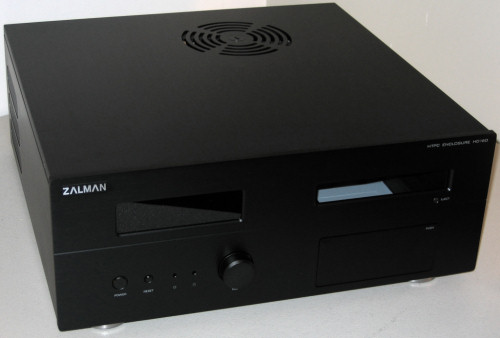

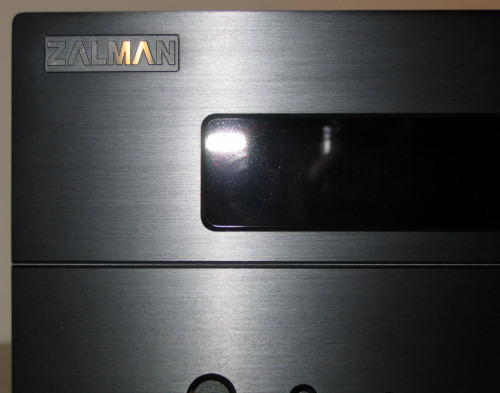
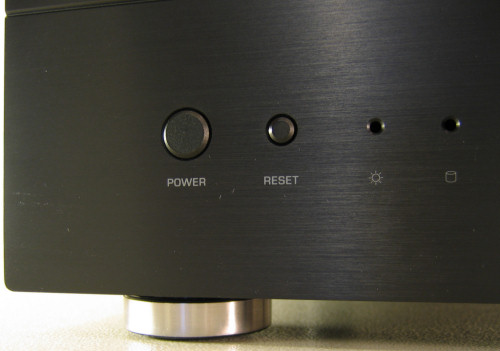
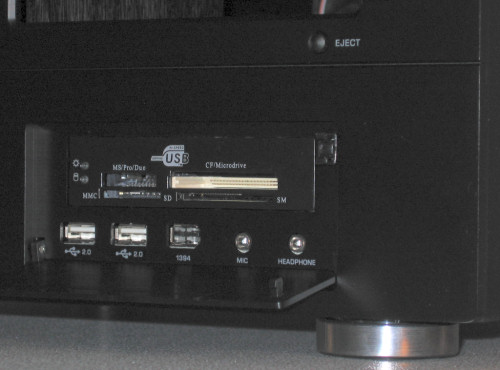
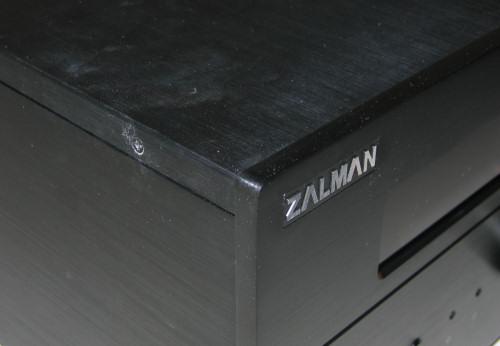








48 Comments
View All Comments
Saist - Wednesday, April 5, 2006 - link
The Thermaltake Bach Media Case weighs in at only $120, about half the cost of the Zalman, and offers similar cooling with a similar design. Okay, so I don't get the remote. That's fine, I already have a remote that works with Linux and MythTV.Okay, so I don't get the inbuilt LED display. That's fine too, I can live without it.
No thanks Zalman, but I'll stick with the Thermaltake for now.
topher42 - Saturday, April 1, 2006 - link
Take a look at the OrigenAE X11.They came out last year.
I put together a HTPC with an X11
in January.
And the Seasonic S12 series of
power supplies are quieter and
cooler.
AnnonymousCoward - Friday, March 31, 2006 - link
MOSFETs? Are you serious? Just call them ICs. Or chips, or silicon. It's not like you're talking about individual discrete transistors, are you?Okay, maybe it's a common term, but I think it's ridiculous.
Stele - Saturday, April 1, 2006 - link
^ Are you serious? Because he was. He meant MOSFETs. The power MOSFETs of the power supply circuitry to the CPU. Yes, he is talking about those individual discrete transistors.It's 'transistors' and ICs that're the more common, and in fact general, term. 'Silicon' is what the actual dies are made of, and you don't have bare silicon around a motherboard so that term's inapplicable here. Reading/understanding would help before shooting your mouth off ;)
AnnonymousCoward - Saturday, April 1, 2006 - link
I didn't know there was such thing as discrete MOSFETs, individually packaged. That doesn't make sense to me. I thought you'd always have an integrated circuit, when there's at least 1 MOSFET present. Surely you can't find a black chip with 3 terminals--gate, drain, and source.So, I stand by my original point that these things should be referred to on an "IC level", not "transistor level". As far as I know, you can't point to an object on the motherboard and say "that's a MOSFET", since you'd be pointing to many of them at once in an IC. Of course, maybe I'm wrong. That's just my understanding, as an EE.
topher42 - Saturday, April 1, 2006 - link
Look up power devices.International rectifier for one.
Maybe a TO-220 package?
You but three terminal mosfets when you
want to control power.
Forinstance on a mother board where you
change the voltage to the cpu in the bios.
The ic's input the the mosfet gate and
the mosfet controls vastly more power
than the ic.
For instance. Cpu is 100 watts at
1.xx volts.
That's 50 to 100 amps, all varied in the
bios.
Do you know of an ic that can do that?
VHDL guy?
AnnonymousCoward - Saturday, April 1, 2006 - link
Okay. I've never heard of MOSFETs used outside of ICs as discrete high power devices. I've used Verilog, but not regularly.Stele - Sunday, April 2, 2006 - link
Hi topher42 ,Not sure what exactly you were driving at as you confused a few terms and concepts there, especially since a MOSFET is an IC.
They come in a fairly wide variety of packages, TO-220 being just one of many. The kind you normally see on motherboards are generally TO-261, DPAK or D2PAK - black, square with a metal tab (soldered to the motherboard) and short legs. Stuff you buy for power amps usually come in TO-3 for max power dissipation, ease of mounting (you can bolt the whole thing on a big heatsink) where compactness is not of concern.
MOSFETs don't have to come with three legs if you want to 'control power', as they have nothing to do with each other... by the way, there are 3, 4 and even 6-leg MOSFETs, depending on design (6-legged ones are usually dual MOSFETs for low-medium power applications where board density is very important).
Em, you can't vary the current (50 to 100 amps, you say) via BIOS, only voltage. And the settings don't go to the MOSFETs directly - they go to the pulse-wave modulation (PWM) controller IC, which then adjusts the output voltage ;)
Hi AnnonymousCoward,
As a professional (i.e., working) EE or EE student you must surely know about MOSFETs being discrete, individually packaged devices as that is the most basic package for them (like any transistor). Yes, you can go to any electronics store, your lab, your working place (or the section that handles EE hardware) or even just browse casually through any semiconductor manufacturer's catalog and find many, MANY MOSFETs in simple, 3-terminal packages (several which I've mentioned already above). With Gate, Drain and Source clearly labelled in the respective datasheets. As a further help to jog your memory (I'm giving you the benefit of the doubt that you already know all this, but perhaps just forgot), the term 'MOSFET' alone in the industry generally refers to the transistor in its discretely packaged form. If one wishes to refer to the MOSFETs inside an IC, it is indicated and understood contextually... e.g. "we suspect excessive drain current in one of the MOSFETs in that design, causing heat and electrical overstress failure on the metal layer".
Integrating them as part of an IC is just an expansion of that concept, and for the same reasons you must surely also know that transistors are the basic building blocks of most ICs; therefore, it is not surprising to see more than one MOSFET, BJT or a combination of the two on the same die in an IC design. Perhaps you'd like to check back with your electronics notes? :)
To refer to the MOSFETs as ICs is not wrong. However, since there are many ICs on the motherboard, it does not at all indicate which specific IC(s) the reviewer was referring to - which, in this case, are the power MOSFETs of the CPU power supply circuitry. You can point them out as MOSFETs, because as already mentioned, the term is understood to refer to discretely packaged MOSFETs - and usually used in power supply circuitry applications.
VHDL and Verilog characterise devices by describing and simulating the chips and systems prior to fabrication, so it's not too useful a tool to learn anything physical about a device, like packaging and so on. That requires a datasheet. :)
AnnonymousCoward - Sunday, April 2, 2006 - link
Thinking about it, in lab once or twice I probably did use a discrete component with 3-4 integrated MOSFETs. I used discrete BJTs more often, though."MOSFETs being discrete, individually packaged devices as that is the most basic package for them"
Most basic, yes, but not the most common. Through college, and now working in the semiconductor industry, I have almost never dealt with discrete MOSFETs. So, in power-controlling applications, when are discrete MOSFETs used and when are relays used?
topher42 - Monday, April 3, 2006 - link
relays have better off isolation.Some small signal fets can achieve
decent off impedance but not power devices.
It's all in what you want to build.
ASIC, FPGA, BJT, power FET.
When I design a op-amp, I want to
use bjt's. And I like power bjt's
for audio power amp outputs.